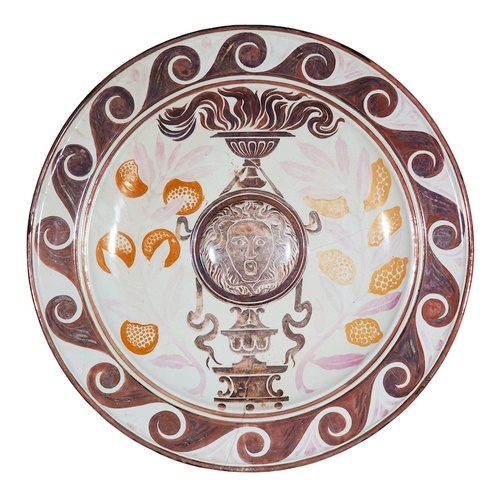A monumental Victorian Arts & Crafts lustre wall charger...
Hammer
£2,000
A monumental Victorian Arts & Crafts lustre wall charger by Maw & Co, Broseley
Glazed in purple, pink and orange on a white ground with central circular Medusa mask surmounted by a flaming brazier, flanked by pomegranates, other seeded fruit and leaves, within a running wave border, impressed marks to the underside 'MAW & Co' and 'BROSELEY', with stapled firing crack, 91cm diameter.
Maw & Co was established by George Maw and his brother Arthur in Worcester in 1850. In 1862 the company moved to Broseley, Shropshire to take advantage of the good-quality local clay and in 1883 they moved again to the Benthall Works in Jackfield, Shropshire. The company continued to prosper and by 1880 had grown to be the largest producer of ceramic tiles in the world. Maw & Co specialised on the earthenware floor tiles, mosaic tiles (from 1862), transfer printed tiles, hand painted picture tiles and relief tiles were also produced and included Art Nouveau and Art Deco geometric designs. In the 1890s Maw & Co started making high quality art pottery (the name they used for it) and employed artists, such as Lewis Foreman Day, William De Morgan and Walter Crane, to design both art pottery and tiles. The stamp underside indicates that the piece was manufactured between 1862 and 1883 while the factory was still located in Broseley. While the company's main output at the time was tiles, it also produced one-off pieces like this for various exhibitions as a showcase of their craftsmanship and techniques. Thus, one of the first examples was made for 1851 Great Exhibition, and a further similar charger was made for 1889 Exposition Universelle (now in the Ironbridge Gorge Museum). It seems likely that the present charger was made for one of such exhibitions, designed by a prominent artist of the era. William De Morgan or Walter Crane seem to be plausible candidates for such design. Crane realised a number of designs for Maw & Co. in 1870's–80's, including a set of lustreware decorated vessels in similar, antiquity-inspired style, for an Arts and Crafts exhibition (The Work of Walter Crane with Notes by the Artist. The Easter Art Annual for 1898: Extra Number of the 'Art Journal'. London: J. S. Virtue, 1898.). The De Morgan Foundation owns a large Maw & Co. charger similarly decorated with vitruvian scroll borders (https://www.demorgan.org.uk/collection/ruby-lustre-charger-with-galleon-within-a-carnation-border/). A vase by an anonymous artist is owned by the V&A Museum, London (http://collections.vam.ac.uk/item/O150401/vase-maw-co/).
View it on
Sale price
Time, Location
Auction House
Hammer
£2,000
A monumental Victorian Arts & Crafts lustre wall charger by Maw & Co, Broseley
Glazed in purple, pink and orange on a white ground with central circular Medusa mask surmounted by a flaming brazier, flanked by pomegranates, other seeded fruit and leaves, within a running wave border, impressed marks to the underside 'MAW & Co' and 'BROSELEY', with stapled firing crack, 91cm diameter.
Maw & Co was established by George Maw and his brother Arthur in Worcester in 1850. In 1862 the company moved to Broseley, Shropshire to take advantage of the good-quality local clay and in 1883 they moved again to the Benthall Works in Jackfield, Shropshire. The company continued to prosper and by 1880 had grown to be the largest producer of ceramic tiles in the world. Maw & Co specialised on the earthenware floor tiles, mosaic tiles (from 1862), transfer printed tiles, hand painted picture tiles and relief tiles were also produced and included Art Nouveau and Art Deco geometric designs. In the 1890s Maw & Co started making high quality art pottery (the name they used for it) and employed artists, such as Lewis Foreman Day, William De Morgan and Walter Crane, to design both art pottery and tiles. The stamp underside indicates that the piece was manufactured between 1862 and 1883 while the factory was still located in Broseley. While the company's main output at the time was tiles, it also produced one-off pieces like this for various exhibitions as a showcase of their craftsmanship and techniques. Thus, one of the first examples was made for 1851 Great Exhibition, and a further similar charger was made for 1889 Exposition Universelle (now in the Ironbridge Gorge Museum). It seems likely that the present charger was made for one of such exhibitions, designed by a prominent artist of the era. William De Morgan or Walter Crane seem to be plausible candidates for such design. Crane realised a number of designs for Maw & Co. in 1870's–80's, including a set of lustreware decorated vessels in similar, antiquity-inspired style, for an Arts and Crafts exhibition (The Work of Walter Crane with Notes by the Artist. The Easter Art Annual for 1898: Extra Number of the 'Art Journal'. London: J. S. Virtue, 1898.). The De Morgan Foundation owns a large Maw & Co. charger similarly decorated with vitruvian scroll borders (https://www.demorgan.org.uk/collection/ruby-lustre-charger-with-galleon-within-a-carnation-border/). A vase by an anonymous artist is owned by the V&A Museum, London (http://collections.vam.ac.uk/item/O150401/vase-maw-co/).



